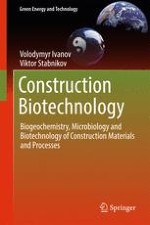2017 | OriginalPaper | Buchkapitel
14. Advances and Future Developments of Construction Biotechnology
verfasst von : Volodymyr Ivanov, Viktor Stabnikov
Erschienen in: Construction Biotechnology
Verlag: Springer Singapore
Aktivieren Sie unsere intelligente Suche, um passende Fachinhalte oder Patente zu finden.
Wählen Sie Textabschnitte aus um mit Künstlicher Intelligenz passenden Patente zu finden. powered by
Markieren Sie Textabschnitte, um KI-gestützt weitere passende Inhalte zu finden. powered by
